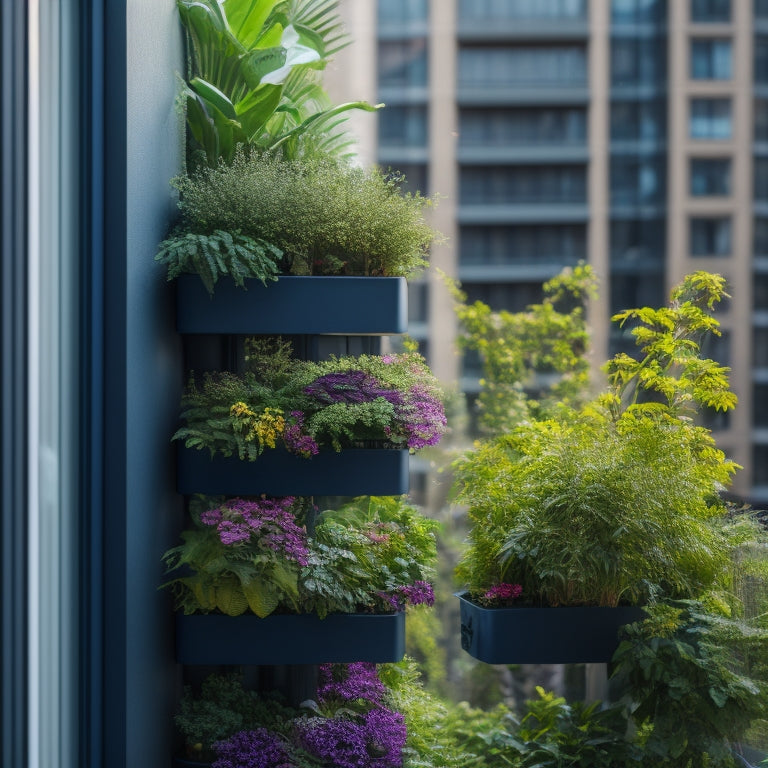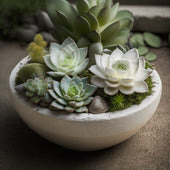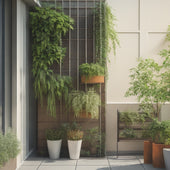
Why Vertical Gardening Thrives in Small Urban Spaces
Share
You thrive in small urban spaces because vertical gardening allows you to maximize every inch of available space, making the most of your balcony, rooftop, or patio to grow your own fruits and vegetables. By utilizing walls and trellises, you can create a space-saving design that promotes efficient use of limited urban areas. Plus, with year-round growing and increased crop yields, you'll enjoy a continuous harvest without compromising on quality. As you explore the world of vertical gardening, you'll discover even more innovative ways to turn your small urban space into a thriving oasis.
Key Takeaways
• Vertical gardening maximizes limited urban spaces using walls and trellises, promoting efficient space utilization and increased crop yield.
• Container gardening allows for control over soil quality, watering, and sunlight exposure, ensuring a healthy and thriving harvest.
• Vertical gardens support continuous harvest through seasonal planting, enabling year-round growing and reducing reliance on industrial agriculture.
• This method reduces maintenance efforts, minimizing weeding, soil erosion, and physical labor required for upkeep, making it ideal for small urban spaces.
• Vertical gardening's controlled water usage and retention promote eco-friendly gardening practices, conserving this valuable resource in urban areas.
Maximizing Space in Urban Areas
In densely populated urban areas, you're constantly competing for space, making it essential to utilize every available inch of land to grow your own food or create a peaceful oasis. One effective way to do this is through container gardening, which allows you to grow plants in small spaces, such as balconies, rooftops, or patios. By using containers, you can control the soil quality, watering, and sunlight exposure, making it ideal for urban environments.
Container gardening is a key component of urban sustainability, enabling residents to produce their own food, reducing reliance on industrial agriculture and transportation. It also provides an opportunity to create green spaces, mitigating the urban heat island effect and improving air quality.
Additionally, container gardens can be easily customized to fit your specific needs and space constraints, making it a versatile and practical solution for urban dwellers. By adopting container gardening, you can contribute to a more sustainable urban environment while enjoying the benefits of fresh produce and a tranquil retreat from the hustle and bustle of city life.
Benefits of Vertical Gardening Systems
As you consider implementing a vertical gardening system in your urban space, you'll quickly realize the numerous benefits it offers.
For one, you'll appreciate the space-saving design options that allow you to make the most of your limited area.
Space-Saving Design Options
You can maximize your urban space by incorporating vertical gardening systems that utilize walls, trellises, or fences to grow vining plants, freeing up valuable floor space for other uses. This approach not only saves space but also adds an aesthetic appeal to your urban design. By choosing the right plant selection and irrigation techniques, you can create a thriving garden in even the smallest of areas.
Here are some space-saving design options to contemplate:
-
Container gardening: use wall planters or hanging gardens to add greenery to your walls.
-
Modular systems: design a customized vertical structure to fit your specific space.
-
Vertical gardens: train vining plants to grow up trellises or fences, making the most of your wall space.
-
Eco-friendly solutions: incorporate recycled materials into your vertical garden design.
-
Mixed planting: combine different plants with varying textures and colors to add visual interest to your vertical garden.
Increased Crop Yields
By incorporating vertical gardening systems into your urban space, you can greatly boost your crop yields, reaping the rewards of more abundant harvests and fresher produce. This is because vertical gardens allow for more plants to be grown in a smaller area, increasing overall yields.
Additionally, vertical gardens promote crop diversity, enabling you to grow a wide variety of fruits, vegetables, and herbs in a single space. This diversity not only adds visual interest to your garden but also encourages a healthier ecosystem.
Effective nutrient management is also key to increased crop yields in vertical gardens. By using a well-balanced fertilizer and ensuring good soil quality, you can provide your plants with the necessary nutrients to thrive.
Moreover, vertical gardens often use hydroponic or aeroponic systems, which deliver nutrients directly to the roots, reducing waste and promoting healthy growth.
With proper nutrient management and crop diversity, you can enjoy a bountiful harvest from your small urban space. By maximizing your yields, you'll be able to enjoy the freshest produce possible, right in your own backyard.
Easy Access for Seniors and Disabled
When you're designing a vertical garden, you'll want to guarantee that it's easily accessible for seniors and people with disabilities.
You can achieve this by positioning the planters at a comfortable height, allowing you to effortlessly reach and pick your harvest without straining.
This way, you'll be able to enjoy an independent gardening experience, regardless of your physical abilities.
Effortless Reach and Pick
Vertical gardens bring plants to a comfortable picking height, allowing seniors and people with disabilities to effortlessly reach and harvest their crops without straining or struggling. You can easily access your plants without having to bend, stretch, or use ladders, making it an ideal solution for those with mobility issues. This ease of access also enables you to adopt efficient harvest techniques, ensuring you get the most out of your vertical garden.
Some benefits of effortless reach and pick in vertical gardening include:
-
Reduced fatigue and discomfort while gardening
-
Increased independence in maintaining your garden
-
Ability to harvest crops at the best time for maximum flavor and nutrition
-
Opportunity to use vertical tools and accessories specifically designed for ease of use
-
Enhanced overall gardening experience, promoting relaxation and enjoyment
Independent Gardening Experience
With effortless reach and pick, you can now enjoy an independent gardening experience, free from the need for assistance or accommodation, allowing you to fully engage with your garden on your own terms.
This sense of autonomy is especially empowering for seniors and individuals with disabilities, who may have previously felt limited in their ability to participate in community gardening initiatives.
Vertical gardening's accessibility features guarantee that everyone can contribute and reap the rewards of their labor, fostering a sense of personal satisfaction and connection to their surroundings.
Increased Crop Yield and Quality
Your vertical garden's crop yield and quality can greatly improve due to the controlled environment and ideal growing conditions it provides. By optimizing the growing space, you can enjoy a bounty of fresh, healthy produce right in your own backyard or balcony.
Here are some benefits you can expect:
-
Crop diversity: With vertical gardening, you can grow a wider variety of crops in a smaller space, ensuring a more diverse and nutritious harvest.
-
Soil health: Vertical gardens often use a well-draining, aerated growing medium that promotes healthy root development and reduces soil-borne diseases.
-
Better light penetration and air circulation lead to stronger, healthier plants.
-
You can space plants closer together, increasing overall yield without sacrificing individual plant health.
-
With precise control over watering, fertilization, and pruning, you can fine-tune your garden's conditions to maximize growth and quality.
Year-Round Growing in Small Spaces
How can you enjoy a steady supply of fresh produce year-round, even in the smallest of urban spaces? The answer lies in vertical gardening's ability to facilitate year-round growing in small spaces. By using seasonal planting and strategic plant selection, you can guarantee a continuous harvest, regardless of the season.
In the spring, plant cool-season crops like lettuce, spinach, and peas. As the weather warms up, shift to warm-season crops like tomatoes, peppers, and cucumbers. In the fall, switch back to cool-season crops, and in the winter, focus on hardy greens like kale and Brussels sprouts. This rotation guarantees that your vertical garden is always producing something fresh and delicious.
When selecting plants, choose varieties that are compact, disease-resistant, and specifically bred for container growing. These plants will thrive in small spaces and produce abundant yields.
Low Maintenance Urban Gardening
You'll appreciate that vertical gardening's space-saving benefits extend to low maintenance, as well, since the upward growth habit and containerized soil reduce soil erosion and weed growth, making it easier to care for your urban garden. This means you can enjoy the fruits of your labor without breaking a sweat. With vertical gardening, you'll spend less time watering, pruning, and fertilizing, giving you more time to relax and enjoy your outdoor space.
Here are some additional benefits of low-maintenance urban gardening:
-
Less water waste: Vertical gardens use a controlled amount of water, reducing waste and conserving this precious resource for urban sustainability.
-
Fewer pests and diseases: Container gardening reduces the risk of pests and diseases spreading from soil to plants, keeping your garden healthy and thriving.
-
Easy harvesting: With plants growing upwards, you can easily pick fresh fruits and veggies without straining your back or knees.
-
Space for creativity: Low-maintenance gardening gives you more time to focus on design and aesthetics, allowing you to express your creativity and personalize your outdoor space.
-
Year-round enjoyment: With vertical gardening, you can enjoy your outdoor space 365 days a year, regardless of the season or weather.
Frequently Asked Questions
Can I Use Vertical Gardening in Areas With Limited Sunlight?
You can still use vertical gardening in areas with limited sunlight by choosing shade-tolerant plants or supplementing with artificial lighting, ensuring your plants receive the necessary light to thrive.
Are Vertical Gardens Expensive to Set up and Maintain?
You'll be relieved to know that vertical gardens don't have to break the bank. Conduct a cost analysis to optimize your setup, and follow maintenance tips like watering efficiently and pruning regularly to keep expenses in check.
How Do I Prevent Pests and Diseases in Vertical Gardens?
You'll prevent pests and diseases in your vertical garden by implementing integrated pest control methods, like neem oil and sticky traps, and disease prevention practices, such as crop rotation, pruning, and sanitizing your equipment regularly.
Can I Grow Root Vegetables in a Vertical Garden System?
You'll be happy to know you can grow root vegetables like carrots, beets, and radishes in a vertical garden system, but choose compact root vegetable varieties and make certain your system provides adequate depth and soil quality for ideal growth.
Are There Vertical Gardening Options for Renters or Non-Homeowners?
You can still enjoy vertical gardening as a renter or non-homeowner by using container gardening or portable planters that can be easily moved or rearranged, providing flexibility and freedom to garden anywhere.
Related Posts
-

What Makes a Great Planter for Succulents
When selecting a great planter for succulents, you'll want to take into account a combination of factors to guarantee...
-

What Makes a Great Planter for Succulents
When selecting a great planter for succulents, you'll want to take into account a combination of factors to guarantee...
-

What Makes a Great Planter for Succulents
When selecting a great planter for succulents, you'll want to take into account a combination of factors to guarantee...
-

What Makes a Great Planter for Succulents
When selecting a great planter for succulents, you'll want to take into account a combination of factors to guarantee...
-

What Makes a Great Planter for Succulents
When selecting a great planter for succulents, you'll want to take into account a combination of factors to guarantee...
-

What Makes a Great Planter for Succulents
When selecting a great planter for succulents, you'll want to take into account a combination of factors to guarantee...
-

What Makes a Great Planter for Succulents
When selecting a great planter for succulents, you'll want to take into account a combination of factors to guarantee...
-

What Makes a Great Planter for Succulents
When selecting a great planter for succulents, you'll want to take into account a combination of factors to guarantee...
-

What Makes a Great Planter for Succulents
When selecting a great planter for succulents, you'll want to take into account a combination of factors to guarantee...
-

What Makes a Great Planter for Succulents
When selecting a great planter for succulents, you'll want to take into account a combination of factors to guarantee...
-

What Makes a Great Planter for Succulents
When selecting a great planter for succulents, you'll want to take into account a combination of factors to guarantee...
-

What Makes a Great Planter for Succulents
When selecting a great planter for succulents, you'll want to take into account a combination of factors to guarantee...
-

What Makes a Great Planter for Succulents
When selecting a great planter for succulents, you'll want to take into account a combination of factors to guarantee...
-

What Makes a Great Planter for Succulents
When selecting a great planter for succulents, you'll want to take into account a combination of factors to guarantee...
-

What Makes a Great Planter for Succulents
When selecting a great planter for succulents, you'll want to take into account a combination of factors to guarantee...
-

What Makes a Great Planter for Succulents
When selecting a great planter for succulents, you'll want to take into account a combination of factors to guarantee...
-

What Makes a Great Planter for Succulents
When selecting a great planter for succulents, you'll want to take into account a combination of factors to guarantee...
-

What Makes a Great Planter for Succulents
When selecting a great planter for succulents, you'll want to take into account a combination of factors to guarantee...
-

What Makes a Great Planter for Succulents
When selecting a great planter for succulents, you'll want to take into account a combination of factors to guarantee...
-

What Makes a Great Planter for Succulents
When selecting a great planter for succulents, you'll want to take into account a combination of factors to guarantee...
-

What Makes a Great Planter for Succulents
When selecting a great planter for succulents, you'll want to take into account a combination of factors to guarantee...
-

What Makes a Great Planter for Succulents
When selecting a great planter for succulents, you'll want to take into account a combination of factors to guarantee...
-

What Makes a Great Planter for Succulents
When selecting a great planter for succulents, you'll want to take into account a combination of factors to guarantee...
-

What Makes a Great Planter for Succulents
When selecting a great planter for succulents, you'll want to take into account a combination of factors to guarantee...
-

3 Best Space-Saving Gardening Ideas for Urban Renters
You can turn even the smallest urban space into a lush oasis by utilizing clever space-saving gardening ideas. Maximi...
-

3 Best Space-Saving Gardening Ideas for Urban Renters
You can turn even the smallest urban space into a lush oasis by utilizing clever space-saving gardening ideas. Maximi...
-

3 Best Space-Saving Gardening Ideas for Urban Renters
You can turn even the smallest urban space into a lush oasis by utilizing clever space-saving gardening ideas. Maximi...
-

3 Best Space-Saving Gardening Ideas for Urban Renters
You can turn even the smallest urban space into a lush oasis by utilizing clever space-saving gardening ideas. Maximi...
-

3 Best Space-Saving Gardening Ideas for Urban Renters
You can turn even the smallest urban space into a lush oasis by utilizing clever space-saving gardening ideas. Maximi...
-

3 Best Space-Saving Gardening Ideas for Urban Renters
You can turn even the smallest urban space into a lush oasis by utilizing clever space-saving gardening ideas. Maximi...
-

3 Best Space-Saving Gardening Ideas for Urban Renters
You can turn even the smallest urban space into a lush oasis by utilizing clever space-saving gardening ideas. Maximi...
-

3 Best Space-Saving Gardening Ideas for Urban Renters
You can turn even the smallest urban space into a lush oasis by utilizing clever space-saving gardening ideas. Maximi...
-

3 Best Space-Saving Gardening Ideas for Urban Renters
You can turn even the smallest urban space into a lush oasis by utilizing clever space-saving gardening ideas. Maximi...
-

3 Best Space-Saving Gardening Ideas for Urban Renters
You can turn even the smallest urban space into a lush oasis by utilizing clever space-saving gardening ideas. Maximi...
-

3 Best Space-Saving Gardening Ideas for Urban Renters
You can turn even the smallest urban space into a lush oasis by utilizing clever space-saving gardening ideas. Maximi...
-

3 Best Space-Saving Gardening Ideas for Urban Renters
You can turn even the smallest urban space into a lush oasis by utilizing clever space-saving gardening ideas. Maximi...
-

3 Best Space-Saving Gardening Ideas for Urban Renters
You can turn even the smallest urban space into a lush oasis by utilizing clever space-saving gardening ideas. Maximi...
-

3 Best Space-Saving Gardening Ideas for Urban Renters
You can turn even the smallest urban space into a lush oasis by utilizing clever space-saving gardening ideas. Maximi...
-

10 Essential Tips to Prevent Disease in Vertical Gardens
You're about to discover the essential strategies to protect your vertical garden from disease, ensuring a thriving a...
-

10 Essential Tips to Prevent Disease in Vertical Gardens
You're about to discover the essential strategies to protect your vertical garden from disease, ensuring a thriving a...
-

10 Essential Tips to Prevent Disease in Vertical Gardens
You're about to discover the essential strategies to protect your vertical garden from disease, ensuring a thriving a...
-

10 Essential Tips to Prevent Disease in Vertical Gardens
You're about to discover the essential strategies to protect your vertical garden from disease, ensuring a thriving a...
-

10 Essential Tips to Prevent Disease in Vertical Gardens
You're about to discover the essential strategies to protect your vertical garden from disease, ensuring a thriving a...
-

10 Essential Tips to Prevent Disease in Vertical Gardens
You're about to discover the essential strategies to protect your vertical garden from disease, ensuring a thriving a...
-

10 Essential Tips to Prevent Disease in Vertical Gardens
You're about to discover the essential strategies to protect your vertical garden from disease, ensuring a thriving a...
-

10 Essential Tips to Prevent Disease in Vertical Gardens
You're about to discover the essential strategies to protect your vertical garden from disease, ensuring a thriving a...
-

10 Essential Tips to Prevent Disease in Vertical Gardens
You're about to discover the essential strategies to protect your vertical garden from disease, ensuring a thriving a...
-

10 Essential Tips to Prevent Disease in Vertical Gardens
You're about to discover the essential strategies to protect your vertical garden from disease, ensuring a thriving a...
-

10 Essential Tips to Prevent Disease in Vertical Gardens
You're about to discover the essential strategies to protect your vertical garden from disease, ensuring a thriving a...
-

10 Essential Tips to Prevent Disease in Vertical Gardens
You're about to discover the essential strategies to protect your vertical garden from disease, ensuring a thriving a...
-

10 Essential Tips to Prevent Disease in Vertical Gardens
You're about to discover the essential strategies to protect your vertical garden from disease, ensuring a thriving a...
-

10 Essential Tips to Prevent Disease in Vertical Gardens
You're about to discover the essential strategies to protect your vertical garden from disease, ensuring a thriving a...
-

10 Essential Tips to Prevent Disease in Vertical Gardens
You're about to discover the essential strategies to protect your vertical garden from disease, ensuring a thriving a...
-

10 Essential Tips to Prevent Disease in Vertical Gardens
You're about to discover the essential strategies to protect your vertical garden from disease, ensuring a thriving a...
-

10 Essential Tips to Prevent Disease in Vertical Gardens
You're about to discover the essential strategies to protect your vertical garden from disease, ensuring a thriving a...
-

10 Essential Tips to Prevent Disease in Vertical Gardens
You're about to discover the essential strategies to protect your vertical garden from disease, ensuring a thriving a...
-

10 Essential Tips to Prevent Disease in Vertical Gardens
You're about to discover the essential strategies to protect your vertical garden from disease, ensuring a thriving a...
-

10 Essential Tips to Prevent Disease in Vertical Gardens
You're about to discover the essential strategies to protect your vertical garden from disease, ensuring a thriving a...
-

10 Essential Tips to Prevent Disease in Vertical Gardens
You're about to discover the essential strategies to protect your vertical garden from disease, ensuring a thriving a...
-

10 Essential Tips to Prevent Disease in Vertical Gardens
You're about to discover the essential strategies to protect your vertical garden from disease, ensuring a thriving a...
-

10 Essential Tips to Prevent Disease in Vertical Gardens
You're about to discover the essential strategies to protect your vertical garden from disease, ensuring a thriving a...
-

10 Essential Tips to Prevent Disease in Vertical Gardens
You're about to discover the essential strategies to protect your vertical garden from disease, ensuring a thriving a...
-

10 Essential Tips to Prevent Disease in Vertical Gardens
You're about to discover the essential strategies to protect your vertical garden from disease, ensuring a thriving a...
-

10 Essential Tips to Prevent Disease in Vertical Gardens
You're about to discover the essential strategies to protect your vertical garden from disease, ensuring a thriving a...
-

10 Essential Tips to Prevent Disease in Vertical Gardens
You're about to discover the essential strategies to protect your vertical garden from disease, ensuring a thriving a...
-

10 Essential Tips to Prevent Disease in Vertical Gardens
You're about to discover the essential strategies to protect your vertical garden from disease, ensuring a thriving a...
-

10 Essential Tips to Prevent Disease in Vertical Gardens
You're about to discover the essential strategies to protect your vertical garden from disease, ensuring a thriving a...


